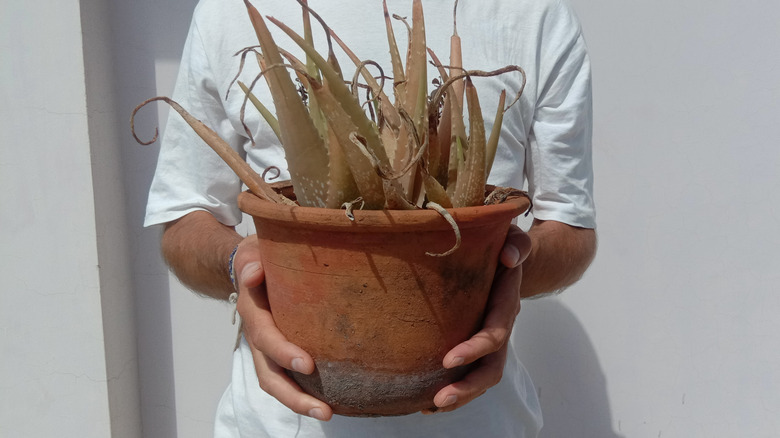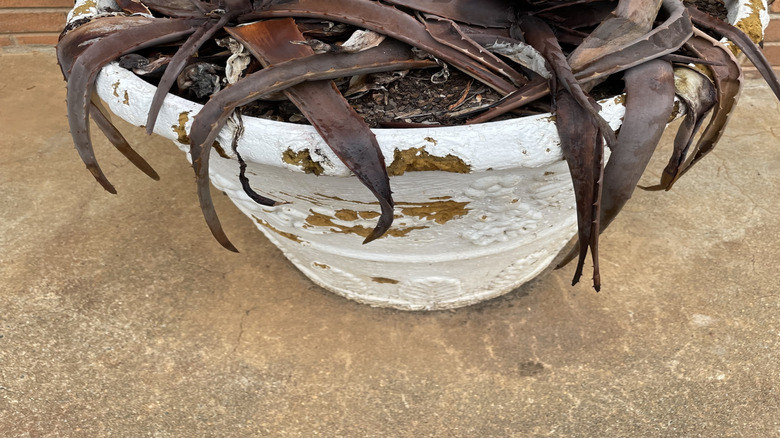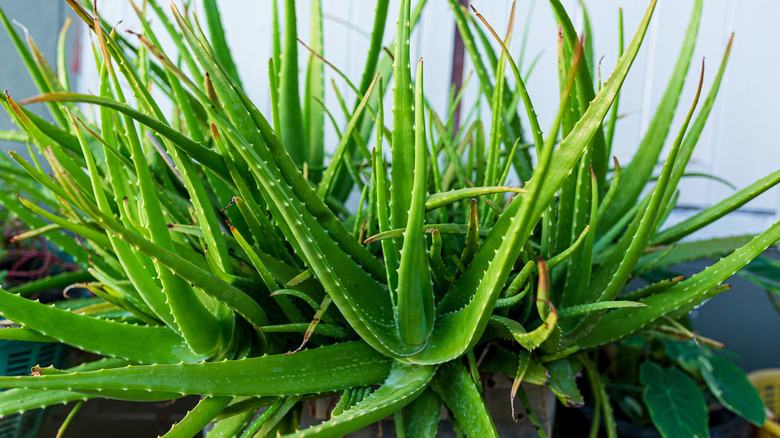Mistakes Everyone Makes With Their New Aloe Vera Plant
Aloe vera is a spiky succulent well-known for its soothing gel that has been used for centuries to treat skin conditions and heal wounds. Today, it is also used topically to treat burns, acne, itchy rashes, and psoriasis. Orally, it's used for weight loss, some forms of inflammatory bowel disease, and even in diabetes treatment. Beyond its potential healing properties, aloe vera is a popular low-maintenance houseplant. Although it is typically hardy and easy to grow, new plant parents often make mistakes — like over- or under-watering, giving their aloe too much or too little sunlight, and neglecting other care requirements — that are far from harmless.
These slip-ups can lead to common aloe issues you need to keep an eye on if you want to avoid damaging your new plant's health and even killing it. Signs that you're making aloe vera growing mistakes include pest infestations from aphids, spider and gall mites, and snout beetles. You might also spot fungal diseases like basal stem rot, sooty mold, and aloe rust. Wilting or discolored leaves and lackluster root systems are other indicators. Thankfully, these mistakes and the problems they cause are largely preventable. Knowing what mistakes to avoid and how to correctly grow and take care of aloe vera plants will help you maintain a gorgeous, thriving succulent.
Mistakes you might be making with your new aloe plant
A mistake many people new to growing aloe plants make is over-watering. It is actually the number one cause of death for succulents and cacti. It's natural to worry that your plants are not getting enough water. That worry can trigger you to water your aloe too much, which causes leaf drop, stagnant soil, and the aforementioned fungal diseases. At the opposite end of the spectrum is under-watering. Not giving your aloe plant enough water can create tough, gray-tinted leaves and shriveled, brown-orange roots.
Some aloe growers do not provide their plants with enough sunlight, leading to poor general health and greater susceptibility to diseases and pest infestations. However, it's also possible to have too much of a good thing: Your aloe plants can get sunburned in direct sunlight. You can tell your aloe is getting too much sun if the leaves are turning orange, yellow, or red. They may wilt, and the tips of the leaves may turn brown and dry. Other mistakes people tend to make with aloe plants include keeping them in incorrect temperatures, especially freezing conditions; giving them too much fertilizer; and not planting them in well-draining soil. Once again, these mistakes can lead to fungal disease, among other issues.
Aloe vera best care practices to correct growing mistakes
You may be wondering how often you should really be watering your aloe vera plant. In general, aloes like water in the summer. Give them a drink every one to three weeks. When the plant heads into winter dormancy, it requires far less water. Test the soil by pushing your finger into it. If it feels dry and the plant's leaves look wilted, water right away. Otherwise, wait a few days. Aloe vera is highly drought tolerant. Plant your aloe in well-draining soil that dries completely in between watering sessions. Once a year, fertilize the plant with a 5-10-5 water-soluble NPK fertilizer made for succulents. The key to preventing hungry insects from ruining your aloe plants is to regularly inspect them for pests and deal with them right away.
Aloes are hardy in Zones 8 through 11, where they can live outside year round. If you garden in a cold climate, your aloe vera plant is better off indoors, providing it gets the right amount of sunlight (and water). At least six hours of sunlight daily is optimal, with direct morning sun and afternoon shade. If your aloe vera normally lives indoors, don't bring it outside without preparation, even if it's a beautiful sunny day. Sudden changes in temperature and sunlight can shock your plant and may even kill it. Over the course of a week, transition your aloe from shady, cool locations that mimic its indoor environments to increasingly sunny, warm locations.


